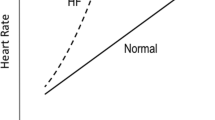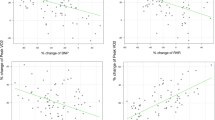Abstract
Heart rate recovery 1 min after exercise termination (HRR-1) is a prognostic predictor. However, the influence of the exercise mode on HRR-1 is incompletely characterised. Twenty-nine young and healthy subjects and 16 elderly patients with chronic heart failure underwent cardiopulmonary exercise testing using cycle ergometer and treadmill ramp protocols in random order. HRR-1 and heart rate recovery 2 and 3 min after exercise (HRR-2, HRR-3) during active recovery and peak oxygen consumption (peak VO2) were measured. In both healthy subjects (32 ± 14 vs. 27 ± 10 bpm) and HF patients (19 ± 8 vs. 14 ± 9 bpm), HRR-1 was faster after cycle exercise (p = 0.029; p for between group difference 0.94). In contrast, HRR-2 and HRR-3 were similar after both tests in both groups. Peak VO2 was lower during cycle as compared to treadmill exercise in both groups. In conclusion, in both healthy subjects and HF patients, HRR-1 depends on the mode of exercise as peak VO2 does.


Similar content being viewed by others
References
American College of Sports Medicine (2000) Guidelines for exercise testing and prescription, 6th edn. Lippincott-Williams and Wilkins, Baltimore
Arena R, Guazzi M, Myers J, Ann Peberdy M (2005) Prognostic characteristics of cardiopulmonary exercise testing in heart failure: comparing American and European models. Eur J Cardiovasc Prev Rehabil 12:562–567. doi:10.1097/00149831-200512000-00008
Arena R, Guazzi M, Myers J, Peberdy MA (2006) Prognostic value of heart rate recovery in patients with heart failure. Am Heart J 151(851):e7–e13
Arena R, Myers J, Williams MA, Gulati M, Kliegfield P, Balady GJ, Collins E, Fletcher G (2007) Assessment of functional capacity in clinical and research settings: a scientific statement from the American heart association committee on exercise, rehabilitation, and prevention of the council on clinical cardiology and the council on cardiovascular nursing. Circulation 116:329–343. doi:10.1161/CIRCULATIONAHA.106.184461
Badruddin SM, Ahmad A, Mickelson J, Abukhalil J, Winters WL, Nagueh SF, Zoghbi WA (1999) Supine bicycle versus post-treadmill exercise echocardiography in the detection of myocardial ischemia: a randomized single-blind crossover trial. J Am Coll Cardiol 33:1485–1490. doi:10.1016/S0735-1097(99)00043-1
Borresen J, Lamberts MI (2007) Changes in heart rate recovery in response to acute changes in training load. Eur J Appl Physiol 101:503–511. doi:10.1007/s00421-007-0516-6
Buchfuhrer MJ, Hansen JE, Robinson TE, Sue DY, Wasserman K, Whipp BJ (1983) Optimizing the exercise protocol for cardiopulmonary assessment. J Appl Physiol 55:1558–1564
Buchheit M, Laursen PB, Ahmaidi S (2007a) Parasympathetic reactivation after repeated sprint exercise. Am J Physiol Heart Circ Physiol 293:H133–H141. doi:10.1152/ajpheart.00062.2007
Buchheit M, Papelier Y, Laursen PB, Ahmaidi S (2007b) Noninvasive assessment of cardiac parasympathetic function: postexercise heart rate recovery or heart rate variability? Am J Physiol Heart Circ Physiol 293:H8–H10. doi:10.1152/ajpheart.00335.2007
Carnethon MR, Jacobs DR Jr, Sidney S, Sternfeld B, Gidding SS, Shoushtari C, Liu K (2005) A longitudinal study of physical activity and heart rate recovery: CARDIA, 1987–1993. Med Sci Sports Exerc 37:606–612
Cole CR, Blackstone EH, Pashkow FJ, Snader CE, Lauer MS (1999) Heart-rate recovery immediately after exercise as a predictor of mortality. N Engl J Med 341:1351–1357
Cole CR, Foody JM, Blackstone EH, Lauer MS (2000) Heart rate recovery after submaximal exercise testing as a predictor of mortality in a cardiovascularly healthy cohort. Ann Intern Med 132:552–555
Gaibazzi N, Petrucci N, Ziacchi V (2004) One-minute heart rate recovery after cycloergometer exercise testing as a predictor of mortality in a large cohort of exercise test candidates: substantial differences with the treadmill-derived parameter. Ital Heart J 5:183–188
Hambrecht RP, Schuler GC, Muth T, Grunze MF, Marburger CT, Niebauer J, Methfessel SM, Kubler W (1992) Greater diagnostic sensitivity of treadmill versus cycle exercise testing of asymptomatic men with coronary artery disease. Am J Cardiol 70:141–146. doi:10.1016/0002-9149(92)91265-6
Hirsh DS, Vittorio TJ, Barbarash SL, Hudaihed A, Tseng CH, Arwady A, Goldsmith RL, Jorde UP (2006) Association of heart rate recovery and maximum oxygen consumption in patients with chronic congestive heart failure. J Heart Lung Transplant 25:942–945. doi:10.1016/j.healun.2006.04.006
Imai K, Sato H, Hori M, Kusuoka H, Ozaki H, Yokoyama H, Takeda H, Inoue M, Kamada T (1994) Vagally mediated heart rate recovery after exercise is accelerated in athletes but blunted in patients with chronic heart failure. J Am Coll Cardiol 24:1529–1535
Jouven X, Empana JP, Schwartz PJ, Desnos M, Courbon D, Ducimetiere P (2005) Heart-rate profile during exercise as a predictor of sudden death. N Engl J Med 352:1951–1958. doi:10.1056/NEJMoa043012
Lamberts RP, Lemmink KAPM, Durandt JJ, Lambert MI (2004) Variation in heart rate during submaximal exercise: implications for monitoring training. J Strength Cond Res 18:641–645. doi:10.1519/1533-4287(2004)18<641:VIHRDS>2.0.CO;2
Lauer MS, Francis GS, Okin PM, Pashkow FJ, Snader CE, Marwick TH (1999) Impaired chronotropic response to exercise stress testing as a predictor of mortality. JAMA 281:524–529. doi:10.1001/jama.281.6.524
Lima RS, De Lorenzo A, Soares AJ (2006) Relation between postexercise abnormal heart rate recovery and myocardial damage evidenced by gated single-photon emission computed tomography. Am J Cardiol 97:1452–1454. doi:10.1016/j.amjcard.2005.11.078
Lind L, Andren B (2002) Heart rate recovery after exercise is related to the insulin resistance syndrome and heart rate variability in elderly men. Am Heart J 144:666–672
Maeder M, Wolber T, Atefy R, Gadza M, Ammann P, Myers J, Rickli H (2005) Impact of the exercise mode on exercise capacity: bicycle testing revisited. Chest 128:2804–2811. doi:10.1378/chest.128.4.2804
Maeder M, Wolber T, Atefy R, Gadza M, Ammann P, Myers J, Rickli H (2006) A nomogram to select the optimal treadmill ramp protocol in subjects with high exercise capacity: validation and comparison with the Bruce protocol. J Cardiopulm Rehabil 26:16–23. doi:10.1097/00008483-200601000-00004
Maeder M, Wolber T, Rickli H, Myers J, Hack D, Riesen W, Weilenmann D, Ammann P (2007a) B-type natriuretic peptide kinetics and cardiopulmonary exercise testing in heart failure. Int J Cardiol 120:391–398. doi:10.1016/j.ijcard.2006.10.016
Maeder MT, Wolber T, Ammann P, Myers J, Brunner-La Rocca HP, Hack D, Riesen W, Rickli H (2007b) Cardiopulmonary exercise testing in mild heart failure: impact of the mode of exercise on established prognostic predictors. Cardiology 110:135–141. doi:10.1159/000110493
Messinger-Rapport B, Pothier Snader CE, Blackstone EH, Yu D, Lauer MS (2003) Value of exercise capacity and heart rate recovery in older people. J Am Geriatr Soc 51:63–68. doi:10.1034/j.1601-5215.2002.51011.x
Myers J (1996) Essentials of cardiopulmonary exercise testing, 1st edition edn. Human Kinetics, Champaign/Windsor/Leeds/Lower Mitcham/Auckland
Myers J, Buchanan N, Walsh D, Kraemer M, McAuley P, Hamilton-Wessler M, Froelicher VF (1991) Comparison of the ramp versus standard exercise protocols. J Am Coll Cardiol 17:1334–1342
Myers J, Do D, Herbert W, Ribisl P, Froelicher V (1994) A nomogram to predict exercise capacity from a specific activity questionnaire and clinical data. Am J Cardiol 73:591–596. doi:10.1016/0002-9149(94)90340-9
Nishime EO, Cole CR, Blackstone EH, Pashkow FJ, Lauer MS (2000) Heart rate recovery and treadmill exercise score as predictors of mortality in patients referred for exercise ECG. JAMA 284:1392–1398. doi:10.1001/jama.284.11.1392
Polonia J, Amaral C, Bertoquini S, Martins L (2006) Attenuation of heart rate recovery after exercise in hypertensive patients with blunting of the nighttime blood pressure fall. Int J Cardiol 106:238–243. doi:10.1016/j.ijcard.2005.02.006
Rahimi K, Thomas A, Adam M, Hayerizadeh BF, Schuler G, Secknus MA (2006) Implications of exercise test modality on modern prognostic markers in patients with known or suspected coronary artery disease: treadmill versus bicycle. Eur J Cardiovasc Prev Rehabil 13:45–50. doi:10.1097/00149831-200602000-00007
Robinson BF, Epstein SE, Beiser GD, Braunwald E (1966) Control of heart rate by the autonomic system: studies in man on the interrelation between baroreceptor mechanisms and exercise. Circ Res 19:400–411
Shetler K, Marcus R, Froelicher VF, Vora S, Kalisetti D, Prakash M, Do D, Myers J (2001) Heart rate recovery: validation and methodologic issues. J Am Coll Cardiol 38:1980–1987. doi:10.1016/S0735-1097(01)01652-7
Sugawara J, Murakami H, Maeda S, Kuno S, Matsuda M (2001) Change in post-exercise vagal reactivation with exercise training and detraining in young men. Eur J Appl Physiol 85:259–263. doi:10.1007/s004210100443
Sung J, Choi YH, Park JB (2006) Metabolic syndrome is associated with delayed heart rate recovery after exercise. J Korean Med Sci 21:621–626. doi:10.3346/jkms.2006.21.4.621
Takahashi T, Hayano J, Okada A, Saitoh T, Kamiya K (2005) Effects of the muscle pump and body posture on cardiovascular responses during recovery from cycle exercise. Eur J Appl Physiol 94:576–583. doi:10.1007/s00421-005-1369-5
Takahashi T, Okada A, Saitoh T, Hayano J, Miyamoto Y (2000) Difference in human cardiovascular response between upright and supine recovery from upright cycle exercise. Eur J Appl Physiol 81:233–239. doi:10.1007/s004210050036
Vivekananthan DP, Blackstone EH, Pothier CE, Lauer MS (2003) Heart rate recovery after exercise is a predictor of mortality, independent of the angiographic severity of coronary disease. J Am Coll Cardiol 42:831–838. doi:10.1016/S0735-1097(03)00833-7
Acknowledgment
MTM is supported by the Swiss National Science Foundation (Grant PBZHB-121007).
Author information
Authors and Affiliations
Corresponding author
Rights and permissions
About this article
Cite this article
Maeder, M.T., Ammann, P., Rickli, H. et al. Impact of the exercise mode on heart rate recovery after maximal exercise. Eur J Appl Physiol 105, 247–255 (2009). https://doi.org/10.1007/s00421-008-0896-2
Accepted:
Published:
Issue Date:
DOI: https://doi.org/10.1007/s00421-008-0896-2




